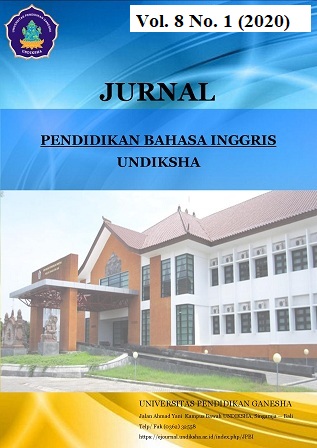SUGGESTION ACTS EXPRESSED BY THE ELEVENTH GRADE STUDENTS AT SMA NEGERI 2 BANJAR
DOI:
https://doi.org/10.23887/jpbi.v8i1.28636Abstract
This study aimed to analyze the social function, text structure, and language features of suggestion acts that expressed by the eleventh-grade students at SMA Negeri 2 Banjar. This research was a descriptive qualitative research and used elicitation technique. The students were given four situations of suggestion acts, such as suggestion of appearance, suggestion of health, suggestion of leisure time, and suggestion of attitude. The results of analysis showed that there were 256 suggestion acts expressed by the eleventh-grade students at SMA Negeri 2 Banjar. Most suggestion acts included recommendation of suggestion acts. There were 192 suggestions included this social function in which the percentage was 75%. Besides, most suggestion acts used text structure of (Subject + Modal Verb + Verb 1). There were 64 suggestion acts used this text structure in which the percentage was 25%. On the other hand, there were 186 suggestion acts used simple present tense in which the percentage was 72%, 109 suggestion acts used specific formula of interrogative form in which the percentage was 42%. Talking about using punctuation of suggestion acts, the most punctuation of suggestion acts that was used by the students was exclamation mark (!), there were 147 suggestion acts used this punctuation in which the percentage was 58%.
Keywords: suggestion acts, social function, text structures, language features
References
Al-Aadeli, N. M. (2013). Suggestion andAdvice in Three Selected Plays. Journalof Education and Practice, V, 14-25.
Altikriti, S. F. (2011). Speech Act Analysis to Short Stories. Journal of LanguageTeaching and Research, II (6), 1374-1384.
Aminifard, Y., Safaei, E., & Askari, H. (2014). Speech Act of Suggestion AcrossLanguage Proficiency and. International Journal of Applied Linguistics & English Literature, III (5), 198-205.
Austin, J. L. (1962). How to Do Things With Words. University Press, Oxford.
Austin, J. L. (1975). How to Do Things With Words. Clarendon Press, Oxford.
Austin, J. L. (2011). How to Do Things With Words. Cambridge: Mass:Harward University Press.
Baktir, H. (2012). Speech Act Theory; Austin and Searle: Derrida's. Language, Literature and CulturreStudies , V (2), 201-210.
Beare, K. (2018). Learning How to Make a Suggestion in English. English Language Journal , 12-20.
Dylgjeri, A. (2017). Analysis of Speech Act. European Journal of Social Sciences Studies , 19-26.
Farnia, M., Sohrabie, A., & Sattar, H. Q. (2014). A Pragmatic Analysis of Speech Act of Suggestion among Iranian Native Speakers of Farsi. Journal of ELT and Applied Linguistics (JELTAL) , II (2), 48-61.
Kemdikbud. (2013). Kurikulum 2013. Jakarta: Kemdikbud.
Martinez-Flor, A. (2005). The Theoretical Review of the Speech Act of Suggestion: Towards a Taxonomy for its Use in FLT. RevistaAlicantina De EstudiosIngleses , 167-187.
Matiki, A. J., &Kgolo, N. N. (2017). A Socio-Pragmatics Analysis of Compliment Responses Among Students at the University of Botswana.Journal of Humanities ,62-87.
Melati, &Nyimas, T. (2017). An Analysis of Students' SociocilturalCmpetence in Delivering Suggestion Speech Act. Advances in Social Science, Education and Humanities Research(ASSEHR) , LXXXII, 116-121.
Meldin, S. A. (2019). Suggestion Acts Performed by English Intructors of Conversation Class in Language Centre of Andalas University. EnglishDepartment Faculty of Language and Arts of Universitas NegeriPadang , XII (2), 109-127.
Mukundan, J., &Khojasteh, L. (2011). Modal Auxiliry Verbs in Prescribed Malaysian English Textbooks. English Language Teaching , IV (1), 79-89.
Nugroho, M., Tarjana, S. S., &Purnanto, D. (2018). The Speech Act of Suggestion by Islamic. Advances in Social Science, Education and Humanities Research, , CLXVI, 401-405.
Oxford. (2010). Advanced Learner's Dictionary. New York: Oxford University Press.
Searle, J. R. (1969). Speech Acts: An Essay in the Pholosophy of Language. Cambridge: Cambridge University Press.
Shofwan, M. I., &Mujiyanto, J. (2018). Realization of Speech Acts of Suggestion by EFL Learners of Universitas Negeri Semarang. English Education Journal , VIII (1), 87- 95.
Trisnawati, I. D., Tantra, D. K., &Adnyani, L. D. (2018). Suggestion Acts Expressed By The Eleventh Gade Students At SekolahMenengahAtas 4 Singaraja. Jurnal Pendidikan Bahasa InggrisUndiksha , V (2), -
Yule, G. (1996). Pragmatics. Oxford: Oxford University Press
Downloads
Published
Issue
Section
License
Authors who publish with the Jurnal Pendidikan Bahasa Inggris Undiksha agree to the following terms:- Authors retain copyright and grant the journal the right of first publication with the work simultaneously licensed under a Creative Commons Attribution License (CC BY-SA 4.0) that allows others to share the work with an acknowledgment of the work's authorship and initial publication in this journal
- Authors are able to enter into separate, additional contractual arrangements for the non-exclusive distribution of the journal's published version of the work (e.g., post it to an institutional repository or publish it in a book), with an acknowledgment of its initial publication in this journal.
- Authors are permitted and encouraged to post their work online (e.g., in institutional repositories or on their website) prior to and during the submission process, as it can lead to productive exchanges, as well as earlier and greater citation of published work. (See The Effect of Open Access)













